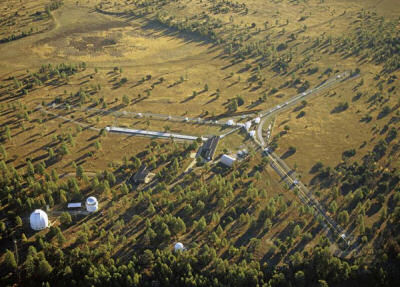
The NPOI is the Y-shaped facility at upper right. Lowell's 1.8-meter, 1.1-meter, and 0.6-meter telescopes are visible at lower left.
LOWELL OBSERVATORY TO LEAD $3.25-MILLION PROJECT TO UPGRADE TELESCOPE ARRAY
[vc_row][vc_column][vc_cta h2=”Feb 20, 2020 Update:”]As of February 2020, The Discovery Channel Telescope (DCT) is now known as the Lowell Discovery Telescope (LDT).[/vc_cta][/vc_column][/vc_row]Flagstaff, AZ. – The Naval Research Laboratory (NRL) has awarded $3,269,000 to Lowell Observatory to upgrade the Navy Precision Optical Interferometer (NPOI) in Flagstaff, Arizona. This will support a project aimed at developing advanced techniques for high-resolution imaging. The improved imaging capability will be applied to astrophysical targets, which will result in new revelations about the nature of extrasolar planets, stellar surface imaging, and the shapes and structures of asteroids.
The NPOI upgrade consists of the addition of three 1.0-meter PlaneWave telescopes. In parallel with this initial 24-month facility upgrade period, a five-year program for the development of advanced techniques for the facility will potentially raise the total grant amount to over $7 million.
Lowell operates the NPOI in partnership with NRL and the U.S. Naval Observatory (USNO). It is an advanced telescope array which links multiple optical telescopes together to form a single, larger synthetic telescope. This technique delivers spatial resolution – the ability for a telescope to ‘zoom’ and pick out fine detail – greater than any single traditional telescope can provide.
Lowell Observatory’s Dr. Gerard van Belle heads the project, nicknamed PALANTIR (Precision Array of Large-Aperture New Telescopes for Image Reconstruction; the name also pays homage to the far-seeing stones in Lord of the Rings). He said, “By combining the already powerful capacity of the NPOI with the new PlaneWave telescopes, we can expect to see an increase of light-gathering capability by a factor of 70 times, enabling detailed observations of significantly fainter objects.”
Lowell will work in conjunction with the NRL on the project. The better light-gathering potential is critical for their efforts to imaging objects in the sky that are far fainter than previously possible.
Lowell will also use its 4.3 meter (169-inch) Discovery Channel Telescope (DCT) to provide supporting high spatial resolution observations, eliminating potential image artifacts from NPOI-only data. Lowell is uniquely positioned to provide this research, with access to both the NPOI and DCT; no other national organization has this combination of advanced telescope assets for solving this pressing problem.
PlaneWave Instruments was founded in 2006 by Richard Hedrick and Joseph Haberman and is a privately held company headquartered in Rancho Dominguez, CA. Through the leadership of its founders and Chief Technologist David Rowe, the company developed and championed the CDK (Corrected Dall-Kirkham) telescope, a revolutionary new optical system that was designed to excel at imaging on large format CCD cameras. Created to meet the demands of researchers, serious imagers, and visual observers, the CDK is an excellent value for a telescope of this quality and aperture.
Rowe said, “We are very excited about this opportunity to work with Lowell Observatory and the Naval Research Laboratory on this groundbreaking project. PlaneWave Instruments CDK1000 represents the next generation of meter-class telescope design and manufacturing capability, and this project will allows us to showcase our innovation and cost effective engineering in a superlative way”.